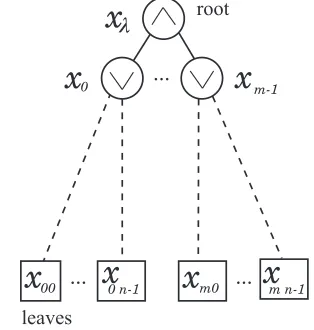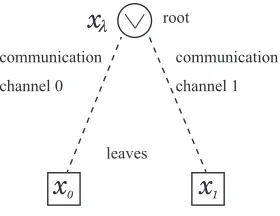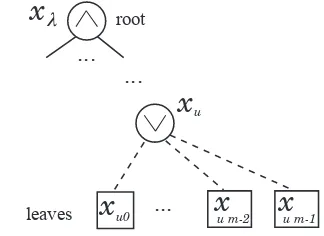An AND-OR-Tree Connected to Leaves via
Communication Channels
Toshio Suzuki,
Member, IAENG
Abstract—We introduce a successor model of an AND-OR tree. Leaves are connected to internal nodes via communication channels that possibly have high probability of interruption. By depth-first communication we mean the following protocol: if a given algorithm probes a leaf then it continues to make queries to that leaf until return of an answer. For each such tree, we give a concrete example of interruption probability setting with the following property. For any independent and identical distribution on the truth assignments (probability is assumed to be neither 0 nor 1), any depth-first search algorithm that performs depth-first communication is not optimal. This result makes sharp contrast with the counterpart on the usual AND-OR tree (Tarsi) that optimal and depth-first algorithm exists. A key to the proof is Riemann zeta function.
Index Terms—Analysis of algorithms and problem com-plexity, AND-OR tree, independent distribution, interruption, Riemann zeta function.
I. INTRODUCTION
A
N AND-OR tree is a mini-max tree whose evaluation function is Boolean-valued, in other words, value is 1 (true) or 0 (false). The root is labeled by AND, child nodes of an AND-gate (an OR-gate, respectively) are labeled by OR (AND, respectively). Each leaf has Boolean value and their values are hidden. An algorithm probes leaves to find the Boolean value of the root, and during computation, the algorithm skips a leaf if unnecessary. Cost of compu-tation is measured by the number of leaves probed during computation. Given a probabilistic distribution on the truth assignments to the leaves, cost means expected value of the above mentioned cost.Computational complexity issues on AND-OR trees have been studied from the early stage of artificial intelligence ([2], [4], [5], [13] and [8]).
On the other hand, current systems of artificial intelligence are often consist of many devices that communicate each other. Interruption of communication is one of potential risks in such systems.
We propose a successor model of an AND-OR tree in which each leaf is connected to an internal node via a communication channel. We are interested in the case where each channel has high probability of interruption. Figure 1 is an example of such a tree. Circles are internal nodes, squares are leaves, solid lines are usual wire, and broken lines are communication channels. In our mind, the main body of the tree is in our local computer, but leaves are on remote devices.
The most simple type of probability distribution on an AND-OR tree is an independent and identical distribution
Manuscript received December 28, 2017; revised January 16, 2018. This work was supported in part by JSPS KAKENHI 16K05255.
Department of mathematics and Information Sciences, Tokyo Metropoli-tan University, Hachioji-city, Tokyo 192-0397, Japan e-mail: toshio-suzuki@tmu.ac.jp
(IID for short). More precisely, an IID is a distribution such that there is a fixed positive real numberp≤1and each leaf has independently has value 0 with probabilityp.
x
λx
x
x
00x
x
x
0
leaves
root
m-1
m0 m n-1 0 n-1
...
...
...
Fig. 1. broken lines are communication channels
A tree is balanced(in the sense of Tarsi [13]) if (1) any two internal nodes of the same depth (the distance from the root) have the same number of child nodes and (2) all the leaves have the same depth.
An algorithmAisdepth-firstif for every internal nodex, once A probes a leaf that is descendant of xthen A does not probe leaves that are non-descendants ofxuntilAfinds
value ofx. A is directional if there is a fixed linear order
of the leaves, and for any truth assignment to the leaves, the order of probe by A is consistent to the above mentioned
linear order [4].
The above (standard) definition of depth-first is not exact for our purpose. In our computation model, “algorithm A
makes a query to leafx” is merely a necessary condition for
“A finds value ofx”.
Thus, we redefine the concept of depth-first, and in addi-tion, introduce concept of depth-first communication.
Definition LetAbe an algorithm on a tree.
1) A performs depth-first search(or simply, Ais
depth-first) if for every internal nodex, once A finds value
of a leaf that is descendant ofxthenAdoes not make
queries to leaves that are non-descendants ofxuntilA
finds value ofx.
2) A (possibly does not perform depth-first search) per-formsdepth-first communicationif for each leaf, once
A makes a query to a leaf, A consecutively makes queries to that leaf until return of an answer.
[image:1.595.341.498.212.377.2]optimal algorithm (its cost achieves the minimum among all algorithms) that is depth-first and directional [13].
Suppose that T is a balanced AND-OR tree, and that
an attached distribution is an IID with 0 < p < 1 (p is
probability of a leaf having value 0). For any leafvand any positive integerk, atkth query tov, assume that probability of interruption depends only on k, not depending on v. Let
f(k) be the probability. We give a particular example of a function f with the following property: Any depth-first algorithm that performs depth-first communication is not optimal (The main theorem).
This result and the above result of Tarsi contrast sharply. Our f(x) is x2/(x+ 1)2. In the proof, a key tool is
Riemann zeta function.
In section III, we observe cost of getting value of a leaf via consecutive access to it through a communication channel. In section IV, we introduce our interruption probability setting on a tree of height 1. In section V, we investigate a tree of general height, and show our main result.
II. PRELIMINARIES
As usual,!and"denote sum and product, respectively. Throughout the paper, an expression of the form!k−1
i=k[· · ·]
denotes 0, and"k−1
i=k[· · ·] denotes 1.
We denote Riemann zeta function [1, Chapter 23] by ζ.
Thus, for each s > 1, ζ(s) = !∞n=1n−s. In particular, ζ(2) =π2/6 = 1.6449· · · andζ(4) =π4/90 = 1.0823· · ·. For two eventsE1 andE2, we denote conditional
proba-bility of E2 underE1 byprob[E2|E1].
The paper given in [9] is a concise survey on complexity and equilibria of AND-OR trees, by which the reader can overview the previous research [3] and its subsequent devel-opments [11], [12] and [7]. For more recent works on this line, see the papers [6] and [10].
III. CONSECUTIVE QUERIES TO A PARTICULAR LEAF In this section, we investigate a single leafx0with a
com-munication channel (Figure 2). A procedureP consecutively
makes queries to x0 until return of an answer.
communication channel
x
0 a leafFig. 2. a single leaf with a communication channel
For each positive integern, we look at the following events En,0 andEn,1.
En,0: “For each j such that1 ≤j < n, jth query to x0
is interrupted (that is, P does not receive an answer)”. En,1: “nth query tox0 is interrupted”.
Lemma 1 (Cost of getting 1-bit information) Let k be a
positive integer. Let αk be expected cost for P to get an answer, under the assumption that for alln,(1)holds.
prob[En,1|En,0] = [(n+k−1)/(n+k)]2 (1)
Then, we have the following.
αk =k2(ζ(2)− k−1
#
j=1
j−2) (2)
Recall that by our convention in the notation section, we have !−1
j=1j−2= 0. Thus, in particular, the following holds.
α1=ζ(2) (3)
Proof:Letf(x) = [x/(x+ 1)]2.
αk =
∞
#
j=1
prob[Ej,0∧¬Ej,1]×j
= ∞
#
j=1
[(
k+j−2
$
i=k
f(i))(1−f(k+j−1))j]
Here, we have the following.
n
#
j=1
[(
k+j$−2
i=k
f(i))(1−f(k+j−1))j]
=
n
#
j=1
[j k+j$−2
i=k
f(i)−j k+j$−1
i=k f(i)]
=
n
#
j=1 k+j−2
$
i=k
f(i)−n k+n$−1
i=k f(i)
=
n
#
j=1
[k/(k+j−1)]2−n[k/(k+n)]2
= k2[
n
#
j=1
(k+j−1)−2−n/(k+n)2]
= k2[
k+n#−1
j=1 j−2−
k−1
#
j=1
j−2−n/(k+n)2]
→ k2(ζ(2)−
k−1
#
j=1
j−2) (n→ ∞) (4)
Hence, (2) holds.
IV. HEIGHT1BINARY TREE
In this section, we investigate a binary OR-tree of height 1 with a communication channel for each leaf (Figure 3). We are going to compare depth-first communication and non-depth-first communication.
Example (Cost of depth-first communication) Let p be
a real number such that 0< p <1. Let dp be an IID such
that probability of a leaf having value 0 is p. Assume that
interruption probabilities are given by (1) withk= 1.
[image:2.595.324.548.340.621.2]communication channel 0
communication channel 1
x
λx
0x
1leaves root
Fig. 3. height 1, binary case
In this model, we investigate the following algorithm
LωRω: Make queries to x0 until x0 returns an answer. If
the value is 0 then make queries to x1 until x1 returns an
answer.
Letcost(LωRω, dp; [n/(n+1)]2)denote the expected cost
of LωRω under dp and the interruption probabilities (5).
Then, by Lemma 1, we have the following.
cost(LωRω, dp; [n/(n+ 1)]2) = α1+pα1
= (1 +p)ζ(2) (6)
Let (LR)ω denotes the following algorithm. Repeat the
following while none ofx0andx1returns an answer: “Make
a query to x0, then make a query to x1”. If xi returns an
answer, break the above loop. If xi is 0 then make queries
tox1−i untilx1−i returns an answer.
Let p and dp be those in Example, and assume that interruption probabilities are given by (5). Let cost((LR)ω, dp; [n/(n+ 1)]2) denote the expected cost of LωRωunder dp and the above interruption probabilities.
We are going to define sequence {βk}k=0,1,2,··· so that
cost((LR)ω, dp; [n/(n+ 1)]2) =!∞
k=0βk. In the following, f(x)denotes[x/(x+1)]2, andα
kis that defined in Lemma 1.
For each i∈{0,1} andn≥1, letE′
n be the event “The
first return from a leaf happens atnth access to the leaves”. Let βn = prob[En′]×(n+pα(n+1)/2) (if n is odd), and βn = prob[En′]×(n+pα(n+2)/2)(if n is even). Then the
following holds.
β1= (1−f(1))(1 +pα1), (7) β2=f(1)(1−f(1))(2 +pα2), (8) β2k+1
= (
k
$
j=1
f(j)2)(1−f(k+ 1))(2k+ 1 +pαk+1), (9)
β2k+2
= (
k
$
j=1
f(j)2)f(k+ 1)(1−f(k+ 1))(2k+ 2 +pαk+2)
(10)
Lemma 2
cost((LR)ω, dp; [n/(n+ 1)]2) = 2ζ(2) + (1−p)(ζ(4)−3) (11)
Proof:It is easy to verify the following.
β2k+1+β2k+2
= (k+ 1)−4
+2k+pαk+1 (k+ 1)4 −
2(k+ 1) +pαk+2
(k+ 2)4
+ 1
(k+ 1)2(k+ 2)2+
p(αk+2−αk+1)
(k+ 1)2(k+ 2)2 (12)
Hence, we have the following.
2k+2#
j=1 βj
=
k+1
#
j=1
j−4+pα1−(2k+ 2 +pαk+2)/(k+ 2)4
+
k
#
j=0
1
(j+ 1)2(j+ 2)2+ k
#
j=0
p(αj+2−αj+1)
(j+ 1)2(j+ 2)2
(13) Here, the following holds.
k+1
#
j=1
j−4→ζ(4) (k→ ∞) (14)
Throughout the rest of the proof, letσxdenote!xj=1j−2.
By Lemma 1, the following hold.
pα1=pζ(2), (15)
(2k+ 2 +pαk+2)/(k+ 2)4
= O(k−3) +p(ζ(2)−σk+1)/(k+ 2)2
→ 0 (k→ ∞) (16)
The third term of (13) is estimated as follows.
k
#
j=0
1 (j+ 1)2(j+ 2)2
=
k
#
j=0
(−(2jj+ 1)+ 12+
2j+ 3 (j+ 2)2+
2 (j+ 2)2)
= −3 + (2k+ 3)/(k+ 2)2+ 2σk+2
→ −3 + 2ζ(2) (k→ ∞) (17) Again, by Lemma 1, we get the following.
(αj+2−αj+1)/(j+ 1)2(j+ 2)2
= [((j+ 1)−2−(j+ 2)−2)ζ(2)−(j+ 1)−4] −((j+ 1)−2−(j+ 2)−2)σj
(18) Here, the sum of[· · ·]has the following limit.
k
#
j=0
[((j+ 1)−2−(j+ 2)−2)ζ(2)−(j+ 1)−4]
= (1−(k+ 2)−2)ζ(2)−
k+1
#
j=1 j−4
[image:3.595.102.242.60.168.2]We are going to show!∞
j=0[((j+ 1)−2−(j+ 2)−2)σj] =
−3 + 2ζ(2). Letabe the left-hand side. Here, we haveσ0=
0, thus we may ignore the term forj= 0.
a =
∞
#
j=1
[(j+ 1)−2 j
#
k=1 k−2
−(j+ 2)−2 j+1
#
k=1 k−2]
+ ∞
#
j=1
(j+ 1)−2(j+ 2)−2
= 1/4− lim
n→∞(n+ 2) −2
n+1
#
k=1 k−2
+ ∞
#
j=1
(j+ 1)−2(j+ 2)−2
= ∞
#
j=0
(j+ 1)−2(j+ 2)−2
= −3 + 2ζ(2) [by (17)] (20)
By (18), (19) and (20), we can evaluate the fourth term of (13).
∞
#
j=0
p(αj+2−αj+1)
(j+ 1)2(j+ 2)2 =p(3−ζ(2)−ζ(4)) (21)
By (13), (15), (16), (17) and (21), we find the cost.
cost((LR)ω, dp; [n/(n+ 1)]2) = ∞
#
j=1 βj
= 2ζ(2) + (1−p)(ζ(4)−3) (22)
In other words, (11) holds.
Corollary Suppose that 0 < p < 1. Then,
cost((LR)ω, dp; [n/(n + 1)]2) is less than
cost(LωRω, dp; [n/(n+ 1)]2).
Proof: By Example and Lemma 2,
cost(LωRω, dp; [n/(n + 1)]2)
− cost((LR)ω, dp; [n/(n+
1)]2) = (1
−p)(−ζ(2)−ζ(4) + 3)>0.
V. THE THEOREM
Now, we investigate a tree of arbitrary height. Let T be a balanced AND-OR tree or a balanced OR-AND tree of height h(≥ 1). Suppose that p is a real number such that 0 < p < 1 and let dp be an IID such that at each leaf, probability of having value 0 is p. Assume that interruption probabilities are given by (5).
Given an algorithm A on T and a real number p, let
cost(A, dp; [n/(n+1)]2)denote the expected cost ofAunder dp and the above interruption probabilities.
Theorem In additon to the above setting, suppose that A
is a depth-first algorithm on T andA performs depth-first communication (see Definition in Introduction). Then A is not optimal.
Proof: We investigate the case where nodes just above leaves are OR-gates. The other case (they are AND-gates) is treated in a similar way.
The case whereT is a binary OR-tree of height 1 is shown by Corollary. In the following,T is assumed to have more than 2 leaves.
Since the distributiondp is an IID and 0< p < 1, there exists an initial segmentγof a computation path ofAonT, such thatγhas positive probability and afterγ,A performs
in the same way asLωRω.
More precisely, γ (its length is, say k ≥ 1) consists of ordered pairs⟨x(i), a(i)⟩(i= 0, . . . , k−1) of leavesx(i)and
truth values a(i) ∈ {0,1}, and in addition there are leaves x(k) andx(k+1), and the following hold.
1) There exists an OR-gate (say,xu) such that x(k) and x(k+1) are its child.
2) At the beginning of computation,A makes queries to x(0) until return of an answer.
3) For each i < k, if an answer of x(i) is a(i) then A
makes queries to x(i+1) until return of an answer.
4) In the presence ofdp and the interruption probabilities
given by (5),Aperforms the moveγ(until getting the
answer a(k−1)) with positive probability.
5) If an answer ofx(k−1)isa(k−1)thenAmakes queries
tox(k)until return of an answer.
6) If an answer of x(k) is 0 then A makes queries to x(k+1) until return of an answer. Then A finds value
of the root.
[image:4.595.60.283.109.287.2]7) If an answer ofx(k)is 1 thenAfinds value of the root.
Figure 4 illustrates the OR-gatexuand its child leaves. For
example,x(k)andx(k+1) are possiblyxu,m−2 andxu,m−1,
respectively. These two leaves are the last two leaves with positive probability.
...
...
...
x
λx
u0x
u
leaves
root
x
x
u m-1 u m-2
Fig. 4. general case
Now, let B be the following algorithm. B simulates A.
However, if history γ (including the instance getting the
answera(k−1)) happens then B performs as(x(k)x(k+1))ω,
in other words, B obeys the following instructions. Repeat
the following while none ofxk andxk+1 returns an answer:
“Make a query toxk, then make a query toxk+1”. Ifxk+i
(i∈{0,1}) returns an answer, break the above loop, and then make queries toxk+1−i untilxk+1−i returns an answer.
By Corollary,B has lower cost thanA.
VI. SUMMARY AND FUTURE DIRECTIONS
[image:4.595.359.521.438.556.2]For any independent and identical distribution on the truth values on the leaves (probability is assumed to be neither 0 nor 1), depth-first algorithms of depth-first communication are not optimal. Our main tool is Riemann zeta function.
The following are future directions.
• Characterization of optimal algorithms in the presence
of the above interruption probability setting.
• Study on words of infinite length as algorithms of
our model. For example,LωRω is an infinite sequence LL· · ·RR· · ·, and(LR)ω is(LR)(LR)
· · ·.
• Application to computation model under emergency
where batteries of devices have loss of power.
ACKNOWLEDGEMENT
We are grateful to anonymous referees for helpful advices.
REFERENCES
[1] Milton Abramowitz and Irene A. Stegun (eds.).Handbook of math-ematical functions: with formulas, graphs, and mathmath-ematical tables, tenth Printing. U.S. Government Printing Office, 1972.
[2] Donald E. Knuth and Ronald W. Moore. An analysis of alpha-beta pruning.Artif. Intell., 6 (1975) 293–326.
[3] ChenGuang Liu and Kazuyuki Tanaka. Eigen-distribution on random assignments for game trees.Inform. Process. Lett., 104 (2007) 73–77. [4] Judea Pearl. Asymptotic properties of minimax trees and
game-searching procedures.Artif. Intell., 14 (1980) 113–138.
[5] Judea Pearl. The solution for the branching factor of the alpha-beta pruning algorithm and its optimality.Communications of the ACM, 25 (1982) 559–564.
[6] Weiguang Peng, NingNing Peng, KengMeng Ng, Kazuyuki Tanaka and Yue Yang. Optimal depth-first algorithms and equilibria of inde-pendent distributions on multi-branching trees.Inform. Process. Lett., 125 (2017) 41–45.
[7] Weiguang Peng, Shohei Okisaka, Wenjuan Li and Kazuyuki Tanaka. The Uniqueness of eigen-distribution under non-directional algorithms.
IAENG Int. J. Comput. Sci., 43 (2016) 318–325.
[8] Michael Saks and Avi Wigderson. Probabilistic Boolean decision trees and the complexity of evaluating game trees. In:Proc. 27th IEEE FOCS, 1986, 29–38.
[9] Toshio Suzuki. Kazuyuki Tanaka’s work on AND-OR trees and subse-quent developments.Annals of the Japan Association for Philosophy of Science, 25 (2017) 79–88.
[10] Toshio Suzuki. Non-Depth-First Search against an Independent Distribution on a Balanced AND-OR Tree. preprint, arXiv:1709.07358[cs.DS] (2017).
[11] Toshio Suzuki and Ryota Nakamura. The eigen distribution of an AND-OR tree under directional algorithms.IAENG Int. J. Appl. Math., 42 (2012) 122–128.
[12] Toshio Suzuki and Yoshinao Niida. Equilibrium points of an AND-OR tree: under constraints on probability.Ann. Pure Appl. Logic, 166 (2015) 1150–1164.



